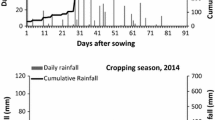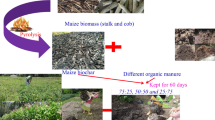Abstract
The use of agricultural crop residues and animal manure for soil amendment is limited in most part of Ethiopia because of high competition for the uses. However, due to low SOM content in most agricultural soils, there is an urgent need for a sustainable management system of agricultural residues to replenish SOM. Vermicomposting is superior among the most efficient recycling techniques for management of available agricultural wastes. The study aimed to investigate the type of crop residues and animal manure available, determinants for their current use, quantity of residue left for composting and farmer’s perception of vermicomposting in three districts of the Benishangul–Gumuz region. Farmers use the largest portion of cereal residue such as sorghum as fuel and tef straw sold at the market and/or as stall-feeding. However, legume residues were consistently preferred for use as a composting material over cereal residues. The average amount of crop residues available for composting was estimated in the range between 0.2 and 0.6 ton year−1 farmer−1, across districts. While the quantity of cow manure used for compost production significantly differs between districts and was estimated 1.7, 1.2, and 0.5 ton year−1 farmer−1 at Bambasi, Assosa, and Homosha districts, respectively. Unlike other parts of Ethiopia, the mixed farmers in the study region well recognized the benefit of animal manures and did not use them as a source of fuel. Residues were found with varying decomposition characteristics that sorghum (10.08% and 1.65%) and tef (9.16% and 1.43%) residues had higher lignin and polyphenol contents, respectively, than maize, soybean, banana, and haricot bean. In terms of their quantity and quality composition, cow and donkey manures, as well as residues of soybean, banana, and maize are the major organic resources potential for utilization in the vermicomposting process in the region. Moreover, the availability of potential organic residues at the farm level could encourage farmer's motive to adopt high-value vermicompost production.




Similar content being viewed by others
References
Sanchez PA, Shepherd KD, Soule MJ, Place FM, Buresh RJ, Izac AMN (1997) Soil fertility replenishment in africa: an investment in natural resource capital. In: Buresh RJ, Sanchez PA, Calhoun F (eds) Replenishing Soil Fertility in Africa SSSA, Special Publication Number 51. Madison, Wisconsin, USA, pp 1–46
Stewart ZP, Pierzynski GM, Middendorf BJ, Vara Prasad PV (2020) Approaches to improve soil fertility in sub-Saharan Africa. J Exp Bot 71:632–641
Smaling EMA, Nandwa SM, Janssen BH (1997) Soil fertility in Africa is at stake. In: Buresh RJ, Sanchez PA, Calhoun F (eds) Replenishing Soil Fertility in Africa SSSA, Special Publication Number 51. Madison, Wisconsin, USA, pp 47–61
Van Beek CL, Elias E, Yihenew GS, Heesmans H, Tsegaye A, Feyisa H, Tolla M, Melmuye M, Gebremeskel Y, Mengis S (2016) Soil nutrient balances under diverse agro-ecological settings in Ethiopia. Nutr Cycl Agroecosyst 106:257–274
Nguru WM, Ng’ang’a SK, Gelaw F, Kanyenji GM, Girvetz EH (2020) Survey data on factors that constrain the adoption of soil carbon enhancing technologies in Ethiopia. Sci data 7:93. 101038/s41597-020-0431-9
Henao J, Baanante C (2006) Agricultural production and soil nutrient mining in Africa, implications for resource conservation and policy development International Center for Soil Fertility and Agricultural Development (IFDC), Muscle Shoals, Alabama 35662, USA, pp 1–13
Sanchez PA (2002) Soil fertility and hunger in Africa. Science 295(5562):2019–2020
Agricultural Transformation Agency (ATA) (2013) Status of soil resources in Ethiopia and priorities for sustainable management GSP for Eastern and Southern Africa Mar 25–27, 2013, Nairobi, Kenya
Nigussie A, Kuyper TW, de Neergaard A (2015) Agricultural waste utilisation strategies and demand for urban-waste compost: Evidence from smallholder farmers in Ethiopia. Waste Manag 44:82–93
Seglah PA, Wang Y, Wang H, Bi Y (2019) Estimation and efficient utilization of straw resources in Ghana. Sustainability 11:4172
Duncan AJ, Bachewe FN, Mekonnen K, Valbuena D, Rachier G, Lule D, Bahta M, Erenstein O (2016) Crop residue allocation to livestock feed, soil improvement and other uses along a productivity gradient in Eastern Africa. Agric Ecosyst Environ 228:101–110. 101016/jagee201605011
Valbuena D, Erenstein O, Kee HS, Tahirou A, Claessens L, Duncan JA, Gerard B, Rufino M, Teufel N, Van Rooyen A, Van Wijik MT (2012) Conservation agriculture in mixed crop livestock systems: scoping crop residue tradeoffs in sub-Saharan Africa and south Asia. Field Crops Res 132:175–184
Chaoui HI, Zibilske LM, Ohno T (2003) Effects of earthworm casts and compost on soil microbial activity and plant nutrient availability. Soil Biol Biochem 35:295–302
Lazcano C, Gomez Brandón M, Revilla P, Domínguez J (2012) Short-term effects of organic and inorganic fertilizers on soil microbial community structure and function- A field study with sweet corn. Biol Fertil Soils 49:723–733. 101007/s00374-012-0761-7
Toyota K, Kimura M (2000) Microbial community indigenous to the earthworm Eisenia foetida. Biol Fertil Soils 31:187–190. 101007/s003740050644
Pathma J, Raman G, Sakthivel N (2019) Microbiome of Rhizospheric Soil and Vermicompost and Their Applications in Soil Fertility, Pest and Pathogen Management for Sustainable Agriculture, In: Panpatte D, Jhala Y, (Eds), Soil Fertility Management for Sustainable Development Springer, Singapore. 101007/978-981-13-5904-0_9
Getachew Z, Adisu T, Abeble L, Anbessa B (2018) Vermicompost potential of common earthworms (Eudrilus eugeniae) and red wiggler (Eisenia fetida) worm on the decomposition of various organic wastes. Int J Soil Sci 24(3):1–13
Institute for Sustainable Development (ISD) (2016) Soil Health Insights from the 2015 Ethiopian Soil Campaign Addis Ababa, Ethiopia
Suthar S (2007) Influence of different food sources on growth and reproduction performance of composting epigeics: Eudrilus eugeniae, Perionyx excavatus and Perionyx sansibaricus. Appl Ecol Environ Res 5:79–92
Getachew Z, Abera G, Beyene S (2017) Rhizobium inoculation and sulphur fertilizer improved yield, nutrients uptake and protein quality of soybean (Glysine max L) varieties on Nitisols of Assosa area, Western Ethiopia. Afr J Plant Sci 11:123–132
Assosa Agricultural Research Center (AsARC) (2007) Assosa Agricultural Research Center Farming system survey Assosa, Ethioipa
Ayanladea A, Radeny M, Morton JF (2017) Comparing smallholder farmers‟ perception of climate change with meteorological data: A case study from southwestern Nigeria. Weather Clim Extremes 15:24–33
Goering HK, Van Soest PJ (1970) Forage fiber analyses (apparatus, reagents, procedures, and some applications). Agriculture handbook no 379, Agriculture Research Service USDA, Washington (DC), USA pp 20
Anderson JM, Ingram JSI (1989) Tropical Soil Biology and Fertility: A Handbook of Methods. CAB International, Wallingford, p 237
Schulte EE, Hopkins BG (1996) Estimation of soil organic matter by weight loss-on-ignition. p 27–38 In Magdoff, FR
Nelson DW, Sommers LE (1973) Determination of total nitrogen in plant material. Agron J 65:109–112
Motsara MR, Roy RN (2008) Guide to laboratory establishment for plant nutrient analysis Food and Agriculture Organization of the United Nations (FAO) Fertilizer and plant nutrition bulletin-19, Rome pp 219
Dossa LH, Abdulkadir A, Amadou H, Sangare S, Schlecht E (2011) Exploring the diversity of urban and peri-urban agricultural systems in Sudano-Sahelian West Africa: An attempt towards a regional typology. Landsc Urban Plan 102:197–206
Berazneva J (2013) Economic value of crop residues in African smallholder agriculture Charles H Dyson School of Applied Economics and Management Cornell University Selected Paper prepared for presentation at the Agricultural and Applied Economics Association's 2013 AAEA and CAES Joint Annual Meeting, Washington, DC, August 4–6, 2013
Tittonell P, Gérard B, Erenstein O (2015) Trade-offs around crop residue biomass in smallholder crop-livestock systems – What’s next? Agric Syst 134:119–128
Valbuena D, Homann-Kee Tui S, Erenstein O, Teufel N, Duncan A, Abdoulaye T, Swain B, Mekonnen K, Germaine I, Gérard B (2015) Identifying determinants, pressures and trade-offs of crop residue use in mixed smallholder farms in Sub-Saharan Africa and South Asia. Agric Syst 134:107–118
Akinola AA, Abdoulaye T, Valbuena D, Erenstein O, Haileslasie A, Germaine I, Shehu M, Ayedun B (2016) Determinants of crop residue use along an intensification gradient in West Africa’s savannah zones. Tropicultura 34:396–410
Jaleta M, Kassie M, Erenstein O (2015) Determinants of maize stover utilization as feed, fuel and soil amendment in mixed crop-livestock systems, Ethiopia. Agric Syst 134:17–23
Middendorf BJ, Pierzynski GM, Stewart ZP, Prasad PVV (2017) Sub-Saharan Africa Soil Fertility Prioritization Report: II Summit Results© Feed the Future Innovation Lab for Collaborative Research on Sustainable Intensification. Kansas State University, Manhattan, KS, p 63
Lule D, Kaba W, Degefa A, Degefa K, Negash M, Mekonnen K, Leta G, Duncan A (2012) Optimizing livelihood and environmental benefits from crop residues in smallholder crop–livestock systems in western Oromia: PRA case studies conducted across eight villages around Nekemte, Ethiopia Nairobi, Kenya: ILRI pp 31
Place F, Barrett CB, Freeman HA, Ramisch JJ, Vanlauwe B (2003) Prospects for integrated soil fertility management using organic and inorganic inputs: evidence from smallholder African agricultural systems. Food Policy 28:365–378
Lupwayi NZ, Girma M, Haque I (2000) Plant nutrient contents of cattle manures from small-scale farms and experimental stations in the Ethiopian highlands. Agric Ecosyst Environ 78:57–63
Negash D, Abegaz A, Smith JU, Araya H, Gelana B (2017) Household energy and recycling of nutrients and carbon to the soil in integrated crop-livestock farming systems: a case study in Kumbursa village, Central Highlands of Ethiopia. GCB Bioenergy 9:1588–1601. 101111/gcbb12459
Lalandera CH, Komakecha AJ, Vinneråsa B (2015) Vermicomposting as manure management strategy for urban small-holder animal farms – Kampala case study. Waste Manag 39:96–103
Kamau JW, Stellmacher T, Biber-Freudenberger L, Borgemeister C (2018) Organic and conventional agriculture in Kenya: A typology of smallholder farms in Kajiado and Murang’a counties. J Rural Stud 57:171–185
Dominguez J, Aira M, Kolbe AR, Gomez-Brandon M, Perez-Losada M (2019) Changes in the composition and function of bacterial communities during vermicomposting may explain beneficial properties of vermicompost. Scientific Reports 9: 9657. 101038/s41598-019-46018-w
Suthar S (2010) Recycling of agro-industrial sludge through vermitechnology. Ecol Eng 36:1028–1036
Pramanik P, Ghosh GK, Ghosal PK, Banik P (2007) Changes in organic – C, N, P and K and enzyme activities in vermicompost of biodegradable organic wastes under liming and microbial inoculants. Bioresour Technol 98:2485–2494
Manna MC, Jha S, Ghosh PK, Acharya CL (2003) Comparative efficacy of three epigeic earthworms under different deciduous forest litters decomposition. Bioresour Technol 88:197–206
Coulibaly SS, Bi IA (2010) Influence of animal wastes on growth and reproduction of the African earthworm species Eudrilus eugeniae (Oligochaeta). Eur J Soil Biol 46:225–229
Garg VK, Chand S, Chhillar A, Yadav A (2005) Growth and reproduction of Eisenia fetida in various animal wastes during vermicomposting. Appl Ecol Environ Res 3(2):51–59
Bertrand M, Barot S, Blouin M, Whalen J, De Oliveira T, Estrade JR (2015) Earthworm services for cropping systems A review. Agron Sustain Dev 35:553–567
Lavelle P, Decaëns T, Aubert M, Barot S, Blouin M, Bureau F, Margerie P, Mora P, Rossi JP (2006) Soil invertebrates and ecosystem services. Eur J Soil Biol 42:S3–S15
Acknowledgements
Zerihun Getachew is a sandwich doctoral granted student at Ghent University and this research is part of his doctoral research work that has been financed by the Special Research Fund (BOF) of Ghent University and also co-funded by Ethiopian Institute of Agricultural Research (EIAR). We thank Ghent University for granting this sandwich doctoral scholarship and the Ethiopian research institute for facilitating the research. I would like to thank all my supervisors specially Professor Stefaan De Neve and Mesfin T. Gebremikael for their tireless valuable feedback on this article.
Funding
Universiteit Gent,no,Zerihun Getachew Gebrehana.
Author information
Authors and Affiliations
Corresponding author
Additional information
Publisher's Note
Springer Nature remains neutral with regard to jurisdictional claims in published maps and institutional affiliations.
Supplementary Information
Below is the link to the electronic supplementary material.
Rights and permissions
About this article
Cite this article
Gebrehana, Z.G., Gebremikael, M.T., Beyene, S. et al. Assessment of trade-offs, quantity, and biochemical composition of organic materials and farmer's perception towards vermicompost production in smallholder farms of Ethiopia. J Mater Cycles Waste Manag 24, 540–552 (2022). https://doi.org/10.1007/s10163-021-01339-9
Received:
Accepted:
Published:
Issue Date:
DOI: https://doi.org/10.1007/s10163-021-01339-9




